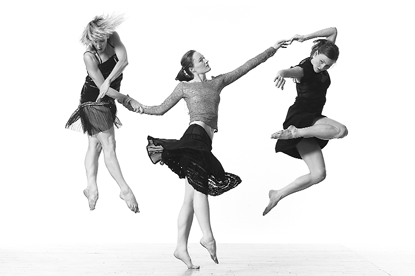Three years in the making, new work makes case for academic life
It’s been four years since the venerated Bebe Miller, once known as a New York choreographer, pulled up her roots and headed for academia. Instead of what she referred to as “studio life,” she now creates work in residencies with her company between June and January, when she is not teaching at Ohio State University.
Next week, the prodigious choreographer returns to the homeland of downtown dance with a four-night run of a new work that incorporates technology—an unusual departure for the humanist dance maker.
“It’s weird to me, too, “ said Miller when asked about the use of technology, “and I am seduced.”
To explain how it happened, Miller recited those words so often uttered by recently former technophobes—“ I switched to Mac.” During a think-tank week on dance and technology, Miller said she got intrigued against her will.
“I tried on Troika Ranch’s suit,” she said referring to a device that allows for real-time physical interactions with digital imagery and sound, developed by technologist Mark Coniglio and choreographer Dawn Stoppiello. “I was not interested in interactivity so much, but as a performer I felt I was in an interesting place of changing my own mental and psychic environment. If technology can change how I see movement, then I can use it in that way.”
The content of the work originated from a trip Miller took to Eritrea in 1999 to teach contemporary movement.
“I was working with people who have no use for irony—just one symptom of many cultural differences,” she explained. “Travel takes you out of your code—you don’t fit. Being inside somebody’s familiar territory, someone else’s idea of imagining—could technology show me that, something about this foreignness?”
Her experience with Troika Ranch’s suit seemed to answer the question,
Like many recent projects in dance and technology, “Landing Place” uses motion-capture mechanisms, but process often trumps product in contemporary dance.
“The essential thing,” said Miller, “is what to do with a tool? During an improvisation in the first two weeks of development, one of the balls fell off the motion-capture suit. On the screen, what you saw was the dancer figure turning into person as they reached to pick it up.”
Transitions thereby became central to the composition, as they have always been in the work of the choreographer’s 20-year-old company.
“Partnering work is what we do,” added Miller. “I’m interested in what happens between people. So we tried experimenting with one dancer in the motion capture suit, one without, so what you end up seeing is a figure being moved by an unseen force—a little extra push of weight, like an ecstatic extension.”
“How all of this has been incorporated in the work is not necessarily apparent,” Miller emphasized. That is why this effort stands out from other dance and technology projects of late.
“The animator [Vita Berezina-Blackburn] moved us away from figure,” she said. “She took our experiments in systems of movement and translated it into a landscape of houses that appears as a figure floating above a duet, like a benevolent constellation.”
“It’s still classic theater where the audience is looking in and looking at a flat projection,” Miller noted. “I haven’t taken the leap into real time or interactivity. I’m really working in how I work—intuitively. It’s not all about metal and aluminum foil, although that has enlarged my imagination. It’s about some other, spiritual grace.”
In concert with the animation, Maya Ciarrocchi’s video will be projected on two large scrims.
“Using projections has been beautiful and hard,” Miller affirmed. “You lean back to look at video and lean forward to look at dance. So the imagery plays with perspective—there is an iconic image of a small house, which is actually a small birdhouse, but it appears by itself 12 feet high. There are many images of place, imagined and real, that create a sensation of living through your land.”
gaycitynews.com


































